Learn how to choose and serve bread for babies and toddlers to ensure it’s safe, easy to eat, and nutritious. Read on tips on cutting bread, which toppings to use, and how to store to maintain freshness.
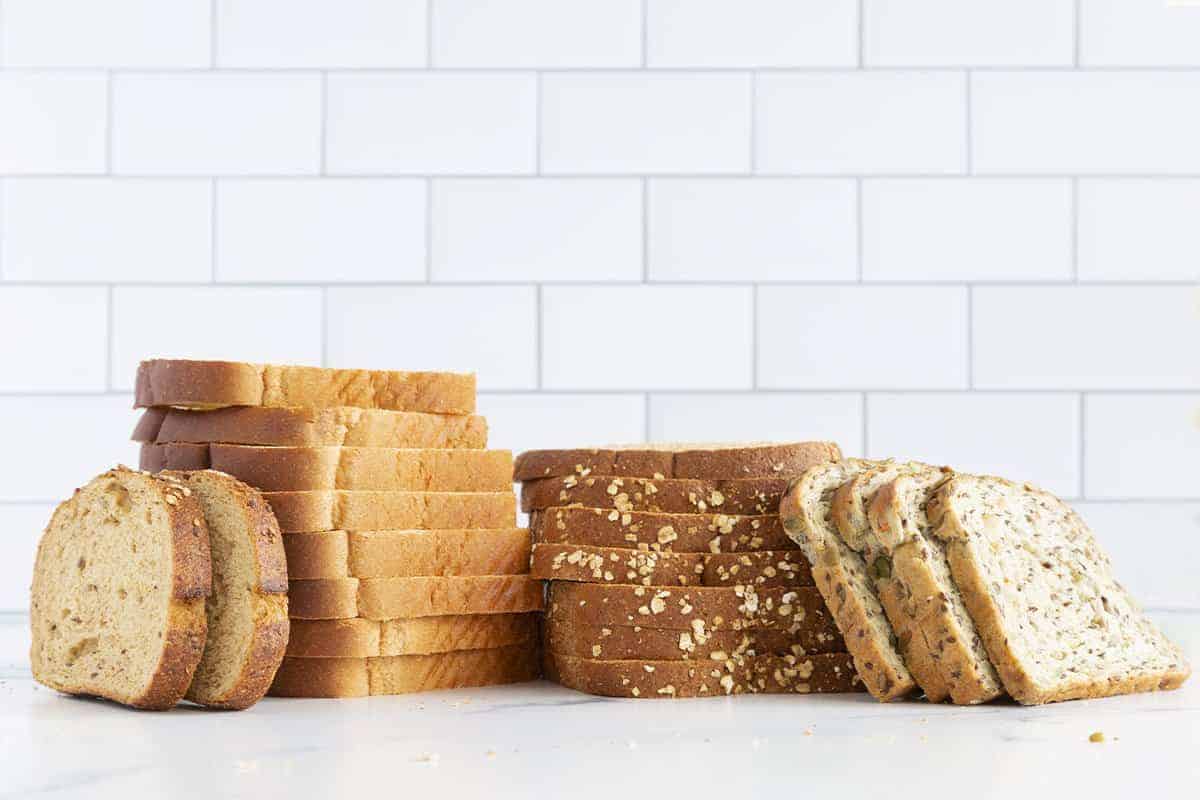
Bread for Babies
Bread is an easy food to keep in the mix for little kids because it’s convenient and can have a wide range of whole grains and complex carbohydrates. There are some considerations, though, to keep in mind when serving bread to babies and toddlers to prevent it from being a choking hazard.
It takes kids time to learn to chew, bite, and move complex textures around in their mouths, so these tips will help you serve bread safely through the early years.
TIP: I have more posts with tips on the best First Foods for babies and how to know when to start solids, too. Plus, tips for babies and toast.
Table of Contents
- Bread for Babies
- Best Bread for Babies
- Best Bread for Baby-Led Weaning
- Toast for Baby
- Bread for Toddlers
- What kind of bread is good for babies?
- Bread Brands to Try
- When can babies eat white bread?
- How to Give Bread to a 6-Month-Old Baby
- Can babies take bread?
- How to Give Bread to a 9-Month-Old Baby
- Bread Recipes for Babies
- Best Tips for Success
- Bread for Babies and Toddlers Recipe
Your toddler won’t eat? Help is here!
Sign up for our email updates to get tips and ideas sent to your inbox.
Best Bread for Babies
The best bread for babies is made with whole grains, has a flavor that isn’t overly sweet, is affordable to you and your family, and is easy for baby to pick up and eat. There is no one “best” option here but many factors to consider when choosing a bread for your child.
(Many breads are sweet in flavor as the fermentation process often creates sweetness, but you may want to avoid breads that are overtly sweet such as sweet rolls, sweet quick breads, and sliced breads with added sugars.)
You do want to avoid breads with large whole seeds or pieces of nuts, as that could be a potential choking hazard. Small seeds, such as poppy seeds or sesame seeds, or cooked small grains are perfectly fine in bread for kids, though, as their size is quite small.
Read up on the best crackers for babies and toddlers, too.)
Best Bread for Baby-Led Weaning
For baby-led weaning, or the style of feeding where baby takes the lead on feeding herself, you’ll want to use a more sturdy bread that is easy to pick up and hold with fingers. You will also want to lightly toast the bread.
Untoasted bread can become thick and hard to move around in a baby’s mouth when mixed with their saliva, and it can become stuck on the roof of a baby’s mouth. It may also be a choking hazard.
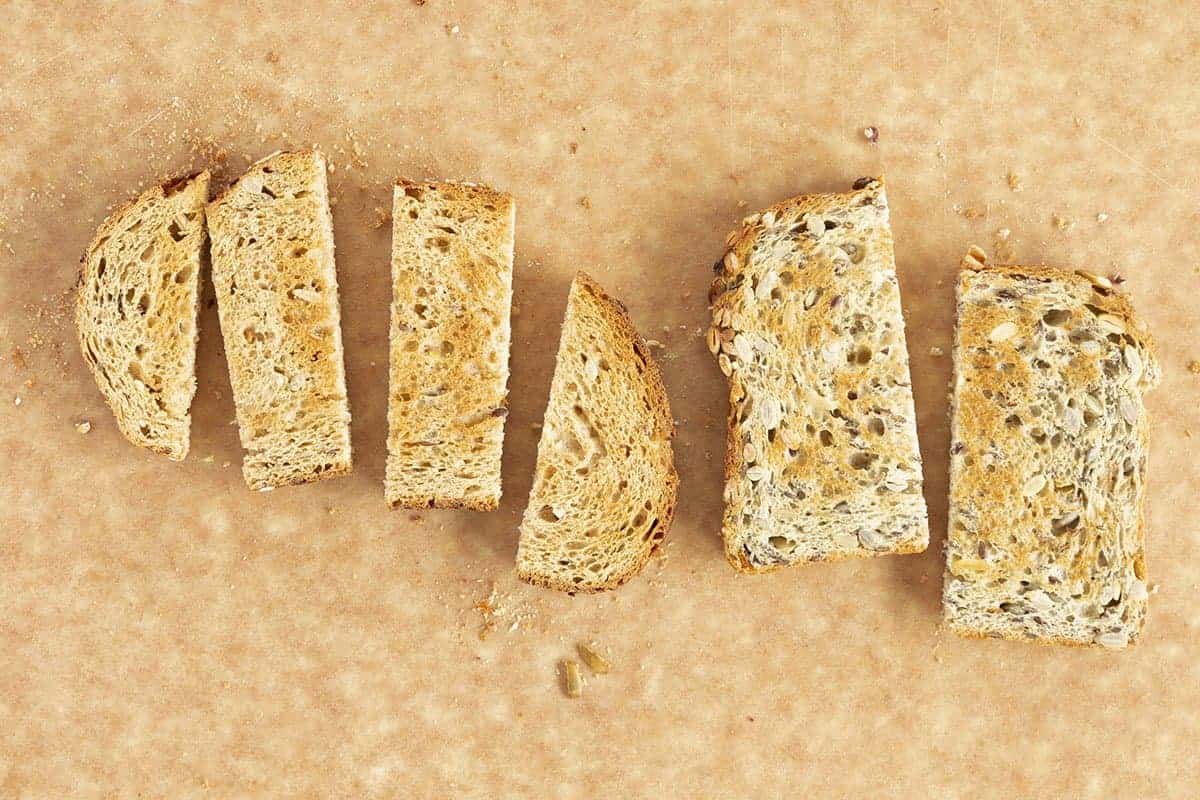
Toast for Baby
To prepare bread for baby-led weaning, lightly toast the bread so it’s golden brown. Then, cut it with a pair of kitchen scissors or a serrated knife to about the size of one or two fingers. That size will be easy for baby to pick up and eat.
Then, you can spread on toppings you like. Nutritious toppings for toast sticks include:
- Mashed Avocado
- Any fruit puree
- Egg Yolk Puree
- A very thin smear of peanut, almond, or sunflower seed butter
- A very thin smear of soft goat cheese
- Plain Greek yogurt
- Mashed raspberries
- Sweet Potato Puree
TIP: You can also put sauces or soups onto bread and let baby suck and gum the flavors off.
Bread for Toddlers
The considerations when choosing a bread for a toddler are similar to that of a baby, though since they will be chewing the bread more than just sucking on it, you may need to pay more attention to bread that is easy to chew.
This may mean that a whole grain sandwich bread is easier for your 1-year-old to chew, when diced small, than an artisanal-style bakery bread. That is normal and the latter option may simply take more time to learn to chew, especially with a thicker crust.
Look for breads made with whole grains, without big seeds or pieces of nuts and that are relatively easy to chew.
You may also prefer a sourdough-style bread for your family, which is also a great option to share with a toddler.
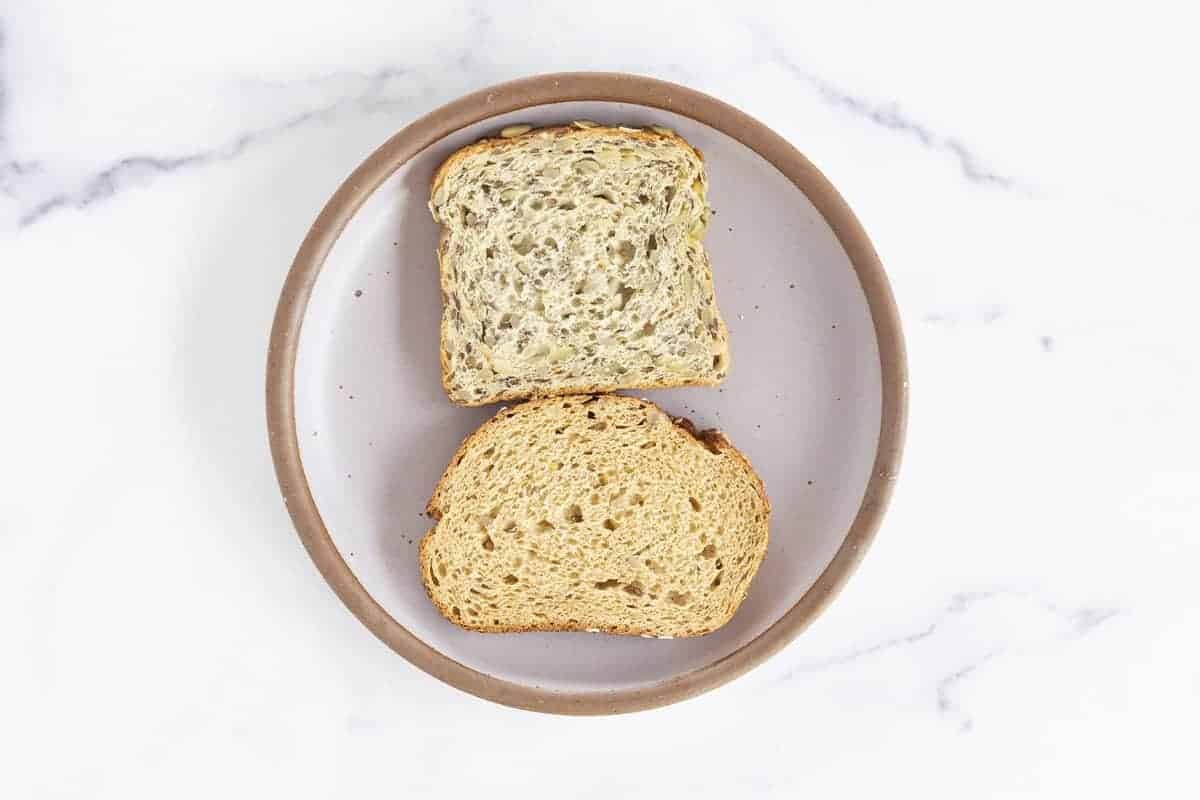
What kind of bread is good for babies?
Generally, a whole grain bread without added sweeteners and without honey is best for baby. Avoid any bread with large seeds (like pumpkin seeds) or big pieces of nuts, as they could be choking hazards. You can also experiment with other types of bread.
You can look for breads made with alternative grains and heirloom wheats, too, if desired.
Very soft sandwich bread may be very difficult for baby to chew, and could be a choking hazard. Lightly toasted bread is a better option.
Bread Brands to Try
You can look for breads including:
- Food for Life Ezekiel Bread (it’s often in the freezer aisle)
- Dave’s Killer Bread (as long as it doesn’t have big seeds, nuts, or honey)
- Silver Hills Breads
- Trader Joe’s sprouted wheat bread
- Store brand whole grain or sprouted grain breads
- You can also look in the fresh bakery section of your grocery store, as many stores have freshly baked whole grain breads on offer.
TIP: Be sure to avoid bread with honey for babies under age 1.
When can babies eat white bread?
Any type of untoasted bread may be too challenging for babies to eat, but soon after a baby turns 1, serving small cubes of bread (think of the size of about 2 peas to start) should be an easy option.
Always sit with baby and include a drink with their meals. If they seem to get bread, toasted or untoasted, stuck on the roof of their mouth, you may want to help them remove it with a finger swipe and dice the pieces smaller as needed with finger foods.
Breads may also be easier to eat as finger foods if they have something moist added to them, such as applesauce, apple butter, or fruit puree. The texture of bread is a challenge for some kids and can take a few months to master.
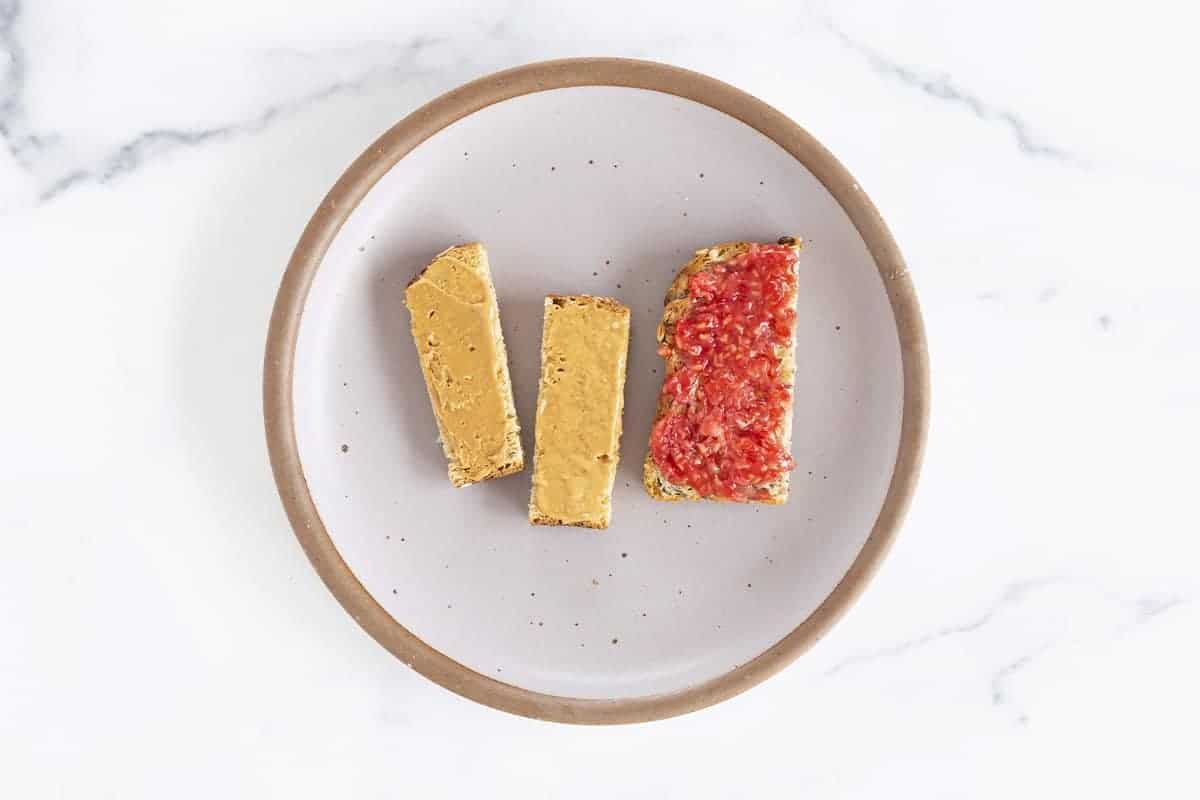
How to Give Bread to a 6-Month-Old Baby
For a 6-month-old child, you can serve bread using the baby-led weaning style: Lightly toast a piece of bread. Cut into sticks about the width of your finger (or two fingers). Add a very thin layer of desired spread such as nut or seed butter, puree, mashed avocado, or hard-cooked egg yolk puree. Let baby suck and gnaw on the bread.
TIP: If the stick of bread breaks in baby’s hand, you can offer a bigger piece.
Can babies take bread?
Yes, babies can take bread as a meal or as part of a meal if it’s served safely. See above for how to serve bread to a 6-month-old baby.
How to Give Bread to a 9-Month-Old Baby
You can continue to offer bread as described above, or you can start cutting it into teensy cubes depending on how your unique child is handling a mix of textures. Do make sure that the pieces are very small (like the size of a pea) and a drink of water during meals to avoid choking concerns.
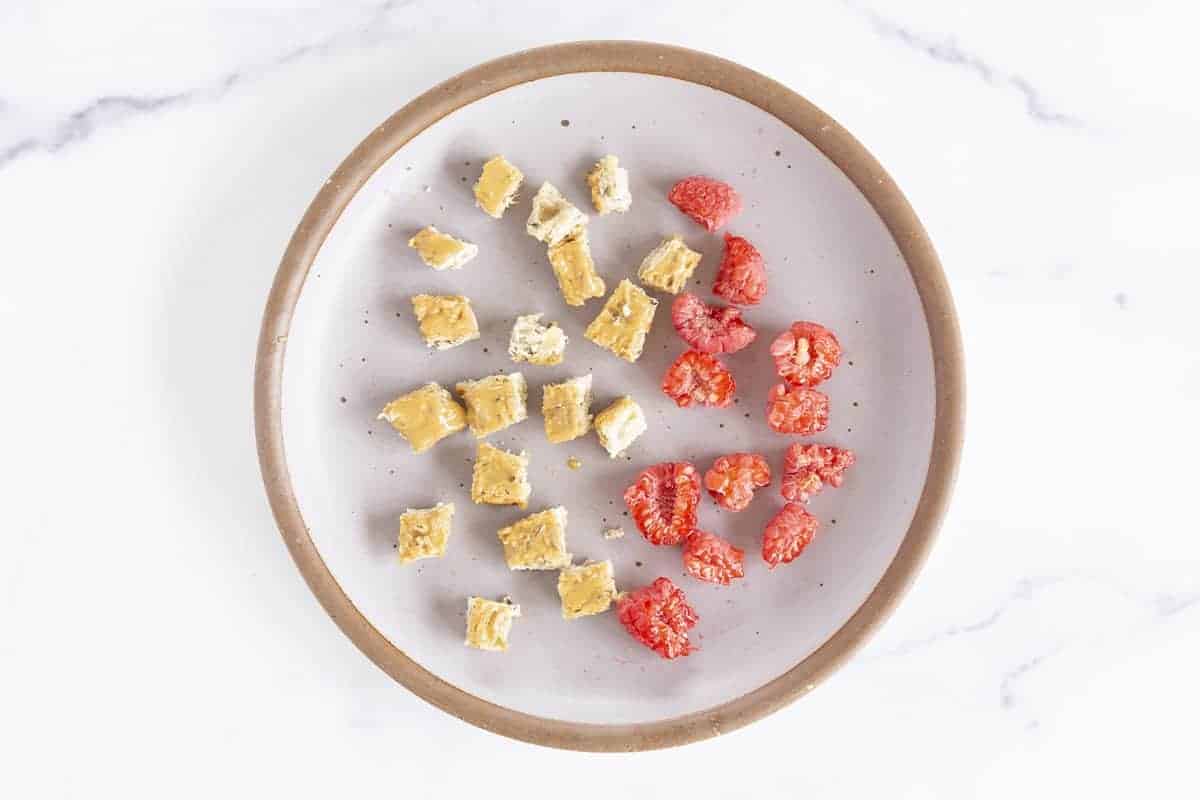
Bread Recipes for Babies
If you want to try making homemade bread, here are some of our favorite options:
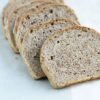
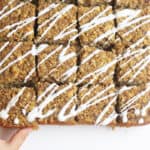
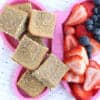
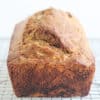
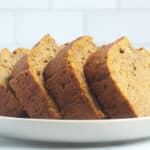

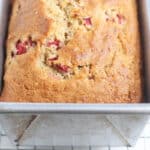
Best Tips for Success
- Look for bread made with whole grains and without honey or large seeds or pieces of nuts.
- Breads made with sprouted grains, alternative grains (such as spelt, buckwheat, or amaranth) can be great options.
- Fermented breads, such as sourdough, are also great options.
- For babies starting at 6 months, you can lightly toast bread and cut it into sticks about the size of 1-2 of your fingers. Add a spread on top in a very thin layer and offer to baby to self feed.
- For toddlers over about 12 to 14 months you can offer very small pieces of lightly toasted diced bread.
- For toddlers over about 16 to 18 months, you can offer sticks of bread for them to practice taking bites from. Use a fork to make a mark where they can put their teeth if this is a new skill to them.
Related Recipes
I’d love to hear your feedback on this post, so please comment below to share!
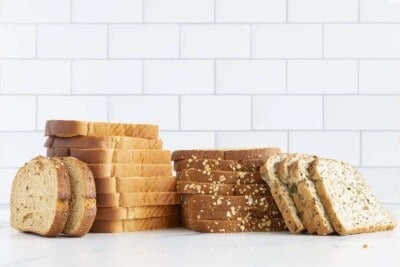
Bread for Babies and Toddlers
Ingredients
- 1 slice whole grain bread
- 1-2 teaspoons topping (such as mashed avocado, fruit puree, vegetable puree, peanut butter, almond butter, sunflower seed butter, mashed fresh raspberries, smooth goat cheese, or farmer's cheese)
Instructions
- Lightly toast the bread.
- Cut into finger-size pieces (either 1-2 of your fingers).
- Add a thin layer of your topping of choice. (If using a nut or seed butter, use a very, very thin layer.)
- Allow baby to self-feed from 6 months if using the baby-led weaning style of feeding. Dice up into tiny pieces for kids over about 1 year.
Notes
- Look for bread made with whole grains and without honey or large seeds or pieces of nuts.
- Breads made with sprouted grains, alternative grains (such as spelt, buckwheat, or amaranth) can be great options.
- Fermented breads, such as sourdough, are also great options.
- For babies starting at 6 months, you can lightly toast bread and cut it into sticks about the size of 1-2 of your fingers. Add a spread on top in a very thin layer and offer to baby to self feed.
- For toddlers over about 12 to 14 months you can offer very small pieces of lightly toasted diced bread.
- For toddlers over about 16 to 18 months, you can offer sticks of bread for them to practice taking bites from. Use a fork to make a mark where they can put their teeth if this is a new skill to them.
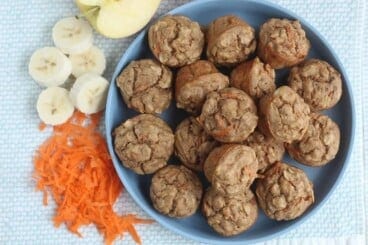
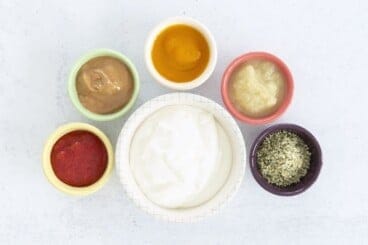
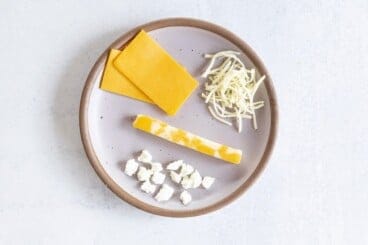
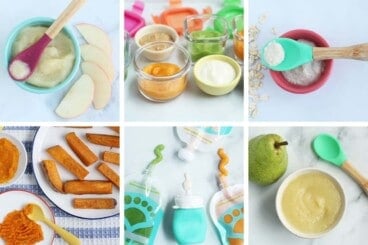


















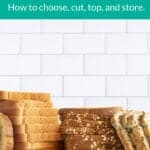
All comments are subject to our Terms of Use.